Dedicated bike lane coming for Broadway in Fidi
For those of us who often get around on two wheels, this will be a welcome addition for getting to the way downtown. While there are routes from Tribeca to Bowling Green and The Battery on the edges, there are no central-island routes through Fidi. And when the DOT did a 12-hour, midweek count, there were 1241 cyclists on Broadway between Cortlandt and Liberty. The plan: by removing one of the four vehicle lanes (one is for buses only) on Broadway between Barclay and Morris, the DOT can add a dedicated bike lane and a narrower metered commercial loading lane (bigger sidewalks would also be great, especially near the transit hub). See the PDF presentation for yourself here.
But wait! There’s more! The notion to make Fidi more pedestrian friendly has some action items in this plan as well:
- Dedicated left turn for John Street. You can see the PDF presentation here.
- A tidying up of the left turn off Broadway at Vesey and onto Park Row and Ann with signal timing and lane signage (good luck with that one)
- Additional painted sidewalk at the Wall Street station, between Wall and Rector
- Another eight feet of painted sidewalk on both sides of the street between Beaver and Pearl
- Another nine feet of painted sidewalk between Pearl and Water
But while we are on the topic, I’d like to rant for a minute about some gaps to be filled downtown, albeit a bit north of this study area. Seventh Avenue has a bike lane north of Houston, but it is abandoned once it becomes Varick south of Houston until you cross Canal. I assume this is because no one at DOT can hash out how to make the tunnel entrance work with a bike lane, but there has to be a way to make a downtown-bound bike lane work there, across five lanes with no street parking.
Similarly if you are biking down Thompson, which works pretty well to get through Soho, there’s no good way to continue downtown once it dead-ends at Duarte Square. Riding west on Canal is a deathwish; riding against traffic on 6th and through Tribeca Park is my favorite option, but it is, of course, illegal. Riding against traffic on St. John’s Lane behind the American Thread works pretty well, since there is no traffic, but a rider still has to get down the little stretch of Laight– usually on the sidewalk — to get to it.
Comment here if you know of other spots that leave a cyclist hanging.







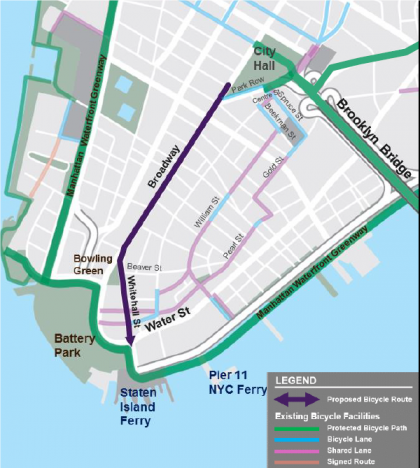
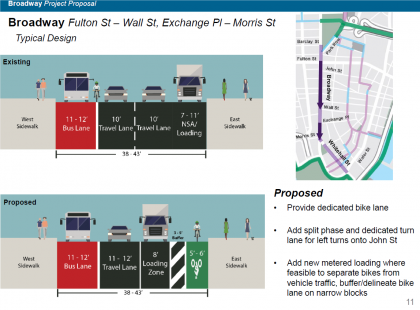
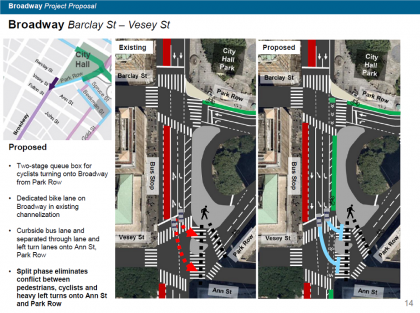
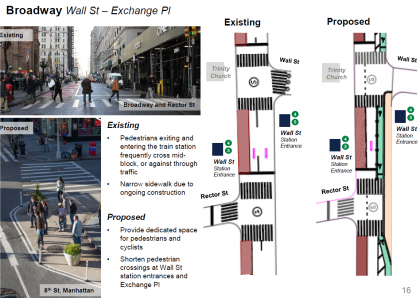
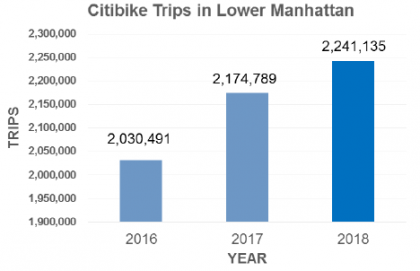






Great news, but share the rant about gaps. Broadway should have a complete protected bike lane south of Union Square. Pathetic to not include NoHo, SoHo, Tribeca, etc.
The amount of buses, trucks and cars make it a very intimidating stretch to bike, when it’s a main thoroughfare for downtown. Where do they think these 1241 bicyclists are coming from?
Half-baked measure, a classic CDOT move.
Thought of another half-baked CDOT design downtown: Going North on Centre from FiDi, they have a protected two-way bike lane that gets you to Brooklyn Bridge and then just…….stops. So if you want to continue going north on the bike lane on Centre, you have to either go off onto City Hall plaza and intermingle with pedestrians (always extremely crowded, especially during warm weather) or salmon one block to the Chambers / Centre intersection.
Why would you not extend the two-way protected bike lane to attach to your other northern bound bike lane? It’s either because DOT is gutless (placard abuse cars park there) or they are incompetent. Neither is a good look.
North of the Brooklyn Bridge, the Lafayette St bike lane should be flipped with the parking lane and made protected to Spring Street and all of the Lafayette St bike lane turned into a two-way bike lane from Union Square to the Brooklyn Bridge (and linked with a protected lane on Park Row to the new lane on lower Broadway).
That’s a great idea that could be implemented with minimal infrastructure changes (an no traffic changes).
Another great example of DOT’s inability to really think when it comes to biking infrastructure.
Congestion pricing — coming in early 2021 — will cut the volume of cars and trucks using Canal and Broome Streets as a toll-free conduit from Long Island to NJ, by tolling the Williamsburg, Manhattan and Brooklyn Bridges. (That is true even if two-way tolling of the Verrazano Bridge continues to be delayed.) This should free up more than enough road space in and around Hudson Square to make it simple to extend the Seventh Ave protected bike lane into and through SoHo and Tribeca.
I’ll start getting excited about all the concessions to bike riders when they start obeying the rules of the road…yielding to pedestrians, stopping at red lights, maintaining a safe speed, etc. Many behave like they own the road.
And own the sidewalks
The bike lane around city hall has created complete gridlock having access to only one lane going straight for park row.
Terrible idea to take away more travel lanes. It’ll just add to the sounds of horns in the early afternoon to late evenings.
How much noise do the bikes make? Perhaps you should be advocating for less polluting (noise and air) modes of transportation if you want more quiet and better air?
Also, numerous studies show that there is induced demand when referring to traffic. Something tells me that even if there were two lanes, you’d probably hear honking. In fact, I’ve often heard honking on roads with 2+ lanes!
https://www.citylab.com/transportation/2018/09/citylab-university-induced-demand/569455/
It’s the cars that are creating gridlock.
Honking cars? In downtown New York? Why I never
Let’s bring back the “No Honking” signs.
Actually, even better, let’s enforce “No Honking Except in Emergency”.
I love the way these bike riders just assume they can do away with all the cars that come into the city without its killing the economy. And how many cars use these streets compared with the 1400 bikes? Are any of thses solutions fair or even-handed at all? Social engineering can be carried much too far, or at least forced at an excessive and punitive rate.
What bothers me is that these changes are never made in consultation with motorists groups or with any consideration at all for the welfare of motorists or even thoughts about maintaining traffic flow to minimize air pollution.
Suddenly, it’s politically incorrect to drive a car into the city and rather than find or create a viable alternative to make the plan practical and reasonable, we just force change. Whatever happened to cooperation and compromise?
American cities and their contiguous suburbs have depended on the automobile for a very long time. A vast number of people who drive into New York can’t reasonably access the city by bike. You can’t just suddenly bring an end to what we have without creating alternatives.
Any studies to back this up? We can provide a few that show bike lanes spur economic growth. Here’s one from Toronto:
https://www.tandfonline.com/doi/full/10.1080/01944363.2019.1638816
Key takeaway: “Using a case–control and pre–post design, we surveyed merchants and shoppers to understand the impacts of the bike lanes on economic activities. We find no negative economic impacts associated with the bike lanes: Monthly customer spending and number of customers served by merchants both increased on Bloor Street during the pilot.”
I’d also point out, and you even state, most people driving and creating the congestion are coming from other places than Tribeca. Tribeca is literally served by almost every subway line, the PATH, countless commuter buses from SI, NJ and LI, etc. It’s not like there aren’t alternatives to get her beside private automobile. Sure there could be more, but we should also be promoting bike lanes which provide the alternatives you are talking about.
I’m glad for this.
Hopefully the coming Congestion reduction beginning next year will also make the streets better for all parties involved: cyclists, pedestrians, and even the (fewer) drivers.
Bikes are great in their lane. But as someone who takes the M55 bus daily downtown for work, I just hope narrowing
the roadway doesn’t force cars into the bus lane making the M55 ,one of the slowest in the city , even slower.